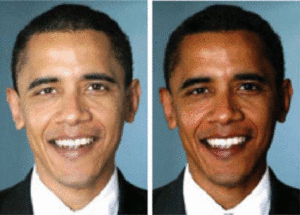
The study, Bias in the Flesh: Skin Complexion and Stereotype Consistency in Political Campaigns, appeared in Public Opinion Quarterly. Its authors, Solomon Messing of the Pew Research Center, Maria Jabon, a LinkedIn software engineer, and Ethan Plaut, a postdoctoral fellow at Stanford University, found that the campaign of Republican presidential nominee John McCain aired negative ads depicting President Obama with darker skin. This was the case particularly when the ads linked Obama to crime. Meanwhile, McCain’s face was depicted as lighter. Further, these ads appeared more frequently as Election Day approached.
“We then conduct an experiment to document how these darker images can activate stereotypes, and show that a subtle darkness manipulation is sufficient to activate the most negative stereotypes about Blacks—even when the candidate is a famous counter-stereotypical exemplar—Barack Obama,” the authors wrote.
Subsequently, they conducted an observational study measuring responses to depictions of the president with varying skin tones. Participants were asked to take part in a word association game as they were shown images of Obama. For each image of Obama they were shown, subjects were given one of 11 word fragments with missing blank spaces, and were asked to fill in the blanks. When the blanks are filled in, each completed word fragment could result in a word that is an anti-Black racial stereotype. The possibilities included: L A _ _ (LAZY): C R _ _ _ (CRIME); _ _ O R (POOR); R _ _ (RAP); WEL _ _ _ _ (WELFARE); _ _ C E (RACE); D _ _ _ Y (DIRTY); B R _ _ _ _ _ (BROTHER); _ _ A C K (BLACK); M I _ _ _ _ _ _ (MINORITY); D R _ _ (DRUG).
When subjects were presented an image of Obama with light skin, 33 percent of people completed a word with an anti-Black stereotype, such as WELFARE or CRIME rather than, say, WELCOME and CROWD. Meanwhile, when participants were shown a dark image of Obama, 45 percent selected a word with a racial stereotype. This shows that dark images of Black people are used to help bring out the most negative racial attitudes in voters.
Past studies have demonstrated that whites associate darker-skinned Blacks with more stereotypical traits—such as dirty, lazy, uneducated– than they do with lighter-skinned Blacks. Further, whites with more Afrocentric features are assigned negative Black stereotypical traits. One study even found that there is psychology and biology involved, as the part of the brain associated with fear conditioning, the amygdala, is triggered in whites when viewing images of darker-skinned Blacks as opposed to lighter-skinned Blacks or whites. These color-coded biases have implications for so many facets of life, including who gets a job, who goes to prison, and who is sentenced to death.
When applied to political campaign ads, the use of racial stereotypes to link blackness with poverty, criminality and other negative racial stereotypes are clear. Max Ehrenfreund of the Washington Post aptly referred to the political tactic as “dog-whistle politics,” in the way that only dogs can hear a dog whistle, only racist voters are plugged into the racist messaging of a campaign ad. A prime example is the 1988 Willie Horton ad, used by then-Vice President George H.W. Bush in his run for the White House against Michael Dukakis. The specter of Willie Horton, a dark Black man, a criminal who rapes and murders white women, was an insidiously powerful tool to rally the troops of the Republican voting base.
While much attention is paid to the blatantly racist messaging of Donald Trump of late, and attempts by establishment Republicans to distance themselves and the party from him, the Republican Party has appealed to white-skin solidarity and a hatred of Black people for decades, beginning in the 1960s with their Southern Strategy. Appealing to states rights, and a white opposition to civil rights, and a tough on crime stance, the GOP was able to direct a gradual exodus of disaffected white segregationists from the Democratic Party to the Republican Party.
As Ehrenfreund noted, the demographics of the Republican Party do not reflect the changing racial and ethnic makeup of the nation. In 2012, 89 percent of Republicans were white, compared to 60 percent of Democrats. Further, 93 percent of Blacks, and three quarters of Latinos and Asians voted for Obama in 2012. Moreover, studies have shown that Republicans are more likely to harbor racist attitudes against people of color, such as a Pew Study that found one-fifth of Republicans opposed interracial dating, and a 2012 Associated Press poll in which 79 percent of Republicans had negative sentiments about Blacks and other racial groups.
Given the effectiveness of these racist campaign ads in helping to galvanize white nationalism and supremacy, it seems white conservative politicians simply cannot help themselves.


